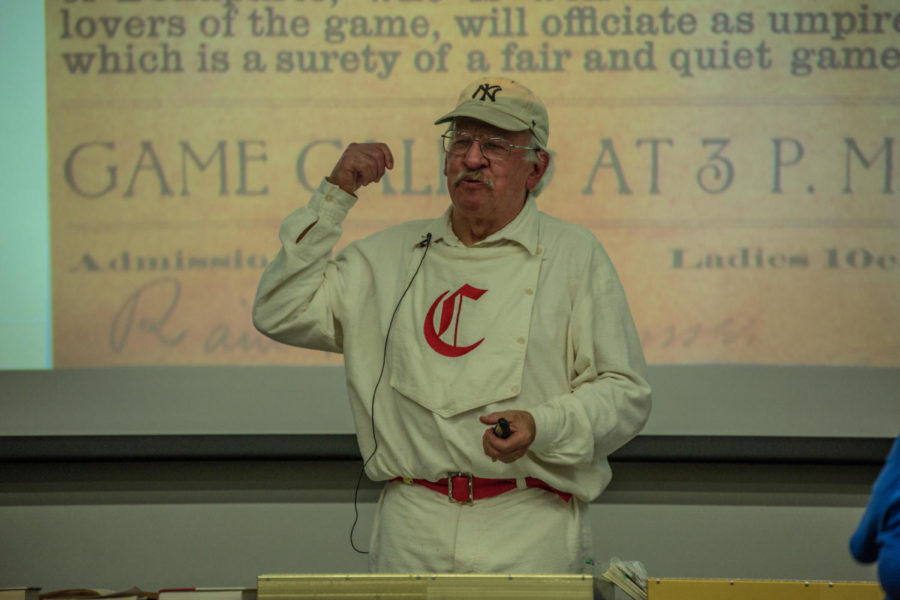Baseball and books: A large baseball collection comes to Ames
October 23, 2018
A man standing next to a massive collection of baseball memorabilia while wearing what seemed to be an old, tarnished uniform addressed an audience at the Ames Public Library on Monday.
The man, John Liepa, spent 18 years in Ames, with eight of those coming at Iowa State University. Coming back to Ames for him was “truly a homecoming.” Liepa set out to discuss the history of baseball in America and Iowa’s role in shaping the sport.
Liepa’s first order of business was to debunk the myth that Abner Doubleday invented baseball. Liepa said on the supposed date of conception in 1839, nothing to do with the sport of baseball happened at all. The myth is based on the eyewitness statement of a man named Abner Graves, according to Liepa.
According to summer attendance sheets from West Point University in 1839, Doubleday attended the university every single day that year. Liepa concluded that baseball was a game developed from other games. As a result of convergence, baseball (or base-ball/base and ball) was slowly built in America.
The first set of rules that resemble today’s were created by Alexander Cartwright in 1845. Cartwright was a member of the New York Knickerbockers, a club team involved in playing town ball. As baseball continued to be played in the ensuing years, the Knickerbockers kept telling other teams of their rules, and soon the “New York Rules” became the standard.
What helped baseball really become nationwide was the Civil War. Northeasterners taught people from all over the country about the rules of baseball.
Those people, including those from Iowa, brought it back to their own states. To give you an idea of how quickly baseball took off in Iowa, there were 18 baseball clubs in Iowa in 1865 (the final year of the Civil War). By 1866, there were 33. By 1867, there were over 200.
“When you started a town you would build a courthouse, a church, and then get a baseball team together,” Liepa said.
Liepa’s personal collection includes memorabilia from all over the nation, but its heart and soul lies in Iowa. He has collectibles from the seven hall of famers born in Iowa — Cap Anson, Dave Bancroft, Fred Clarke, Red Faber, Bob Feller, Dazzy Vance and J.K. Wilkinson.
Additionally, he has a card of 80 percent of the players that have played in the MLB from Iowa. There have been 221 Iowans who have played in the majors.
Some of the Iowa players are harder to find than exclusive Babe Ruth cards that sell for hundreds of thousands of dollars. Forty-three Iowans played in fewer than 10 games in the MLB, making their cards very uncommon. Because minor league cards are more rare than MLB cards, they can be extremely tough to find to add to his collection.
But John loves the challenge.
He does it not for the money, but for the stories about each player. He said he loves learning about individuals.
“As a former teacher, I know that history is a process, and I love the process just as much as I love the cards themselves,” Liepa said.
Some of his most prestigious memorabilia is from the Cincinnati Red Stockings, the first openly professional baseball team. The first item is a team picture of the Red Stockings from 1869.
To his knowledge, only about 23 copies exist. Furthermore, he has an autograph from one of the players on that team, Calvin McVey. McVey was from Montrose, Iowa, and played a key role on a team that won 84 games in a row from 1869 to 1870. He has an autograph from McVey, one of only two in the world.
“Well, my realtor told me to insure it for a million dollars,” Liepa said about the McVey autograph.
Oh, and that uniform he was wearing — an original Cincinnati Red Stockings one from 1869.
Liepa concluded that even though Iowa doesn’t have a Major League team, it doesn’t mean Iowa hasn’t had an impact on the legacy of baseball.







